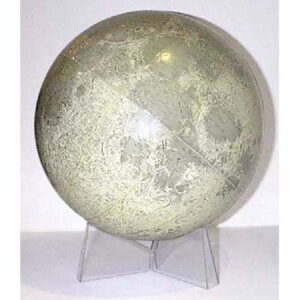Description
The United States includes only the states east of the Mississippi, shown as a single region, with west of the Mississippi divided into two regions, a northern portion shaded green, and a southern portion outlined in yellow, labeled New Mexico and Mexico. California is shown as a peninsula. Australia is labeled “New Holland” and divided in half, with the northwest coast labeled Van Dieman’s Land 1615 and an inscription in the eastern half “New South Wales Explored by Cook 1770.” Antarctica is unmapped, with a few regions labeled as having islands or fields of ice reflecting geographic knowledge at the time. The Hawaiian Islands are called the Sandwich Islands. Tracks of Cook’s voyages are indicated.
A James Wilson globe should be the cornerstone of any major collection. James Wilson (1763-1855), a Bradford, Vermont, farmer and blacksmith by trade, is the father of American globe making. Wilson was the first American to manufacture globes, having been inspired by European globes he saw at nearby Dartmouth College. A self-taught geographer and engraver, he not only made the globe spheres but designed, engraved and printed the cartographic gores for them. Wilson began his business in Bradford in about 1810. and in 1815 moved to New York State, opening a larger and better-equipped globe manufacturing facility at 110 Washington Street in Albany. In 1817, his eldest son Samuel joined the business and the following year, his son John became a primary partner with his father. Another son, David Wilson worked briefly in the family business, designing a three-inch globe. The firm of J. Wilson & Sons quickly became known as a globe making family enterprise. Cyrus Lancaster, a graduate of Dartmouth College and a school instructor, joined the firm in 1827. Following the deaths of Samuel and John Wilson, Lancaster continued as business manager, and two years later became a member of the family, marrying Samuel’s widow, Rebecca. Lancaster produced a number of globes in Albany under the Wilson name, the last dated one in 1845.
By 1810 Wilson noted sales of his hand-made globes in his account books (Tucker, 273; Haskins, 324; Dartmouth 3). An undated Wilson terrestrial globe in the Vermont Historical Society and another at Harvard University are thought to be examples of the 1810 Wilson terrestrial globes. In 1811, Wilson made the first known published and dated American terrestrial globe — 13 inches in diameter. In 1812 he issued the first published and dated American celestial globe also 13 inches. The offered 9-inch globe, dated 1819. is among his earliest issued in that size.
Read more about the firm on our Guide to Globe Makers.
Cartouche: THE/ AMERICAN NINE INCH/ TERRESTRIAL GLOBE./ EXHIBITING,/ with the greatest possible Accuracy,/ THE POSITIONS OF THE PRINCIPAL KNOWN/ PLACES OF THE EARTH;/ with New Discoveries & Political Alterations/ down to the present/ PERIOD:/ 1819/ BY J. WILSON & CO./ Albany
Condition: Generally very good, recently professionally restored and revarnished, with the usual remaining expected light toning, wear and restorations to minor scattered cracks and abrasions. Stand generally very good with the usual wear and shrinkage.
References:
Dekker, Elly and van der Krogt, Peter. Globes from the Western World. London: Zwemmer, 1993. pp. 125, 130-33, 139. (illustrating Wilson globe in National Museum of American History).
Fowle, Richard J. “James Wilson’s Globes.” Vermont History, XXVIII. 1960. pp. 245-49.
Haskins, Harold Web. “James Wilson — Globe Maker.” Vermont History, XXVII. 1959. pp. 319-330.
Kimball, LeRoy E. “James Wilson of Vermont, America’s First Globe Maker.” Proceedings of the American Antiquarian Society, Massachusetts: 1938. pp. 29-48.
The Dartmouth Compass. Vol. 1, No. 4, Autumn 1982.
Tyner, Judith. “A World of Their Own, James Wilson and the First American Globe.” Mercator’s World. January/February 1999.
Yonge, Ena L. A Catalogue of Early Globes, Library Series No. 6. American Geographical Society, 1968. p. 69 -70.
















